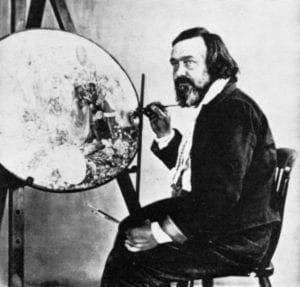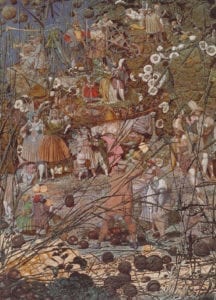JMS Pearce
Hull, England

Portrait of British painter Richard Dadd (1817-1886) showing painting Contradiction: Oberon and Titania. Henry Hering. circa 1856. Source Unknown. Public Domain due to age.
Is there anything so extravagant as the imaginations of men’s brains? Where is the head that has no chimeras in it? . . . Our knowledge, therefore is real only so far as there is conformity between our ideas and reality of things. . . – (John Locke, An Essay Concerning Humane Understanding: 1690)
There are many examples of great exponents of music, writing, and painting who at some time in their lives were mentally deranged, and often committed to institutions for mental illness. Some ended in suicide. It has been argued that creative art is linked to eccentricity, which may merge into madness. The artist Richard Dadd is of particular interest. Almost certainly schizophrenic, he committed murder, was confined to an asylum for life, yet continued to produce art sometimes regarded as works of genius. Many of his paintings and surviving medical records remain in the Bethlem Royal Hospital, Museum of the Mind, recently revealed by Nicholas Tromans, who diligently examined Dadd’s art and the relationship between art and the treatment of mental illness in the nineteenth century.1
Richard Dadd (1817-1886)
Dadd (Fig 1.) was born in Chatham Kent, the fourth of Robert and Mary Ann Dadd’s seven children, four of whom were to die insane.2 He studied at the Royal Academy, where he was an outstanding student and became fascinated by works of religion, fantasy, Shakespearean, and classical themes.3 He painted in oils and watercolor; his subjects included portraits and scenes from history and literature, many of which are exhibited at Suffolk Street Galleries, the British Institution, and the Royal Academy.
In 1842, Dadd was invited to be a draughtsman for Sir Thomas Phillips on his grand tour of Europe and the Middle East. When they reached Syria, Dadd recorded his mental disturbance in a letter to a friend: “I have lain down at night with my imagination so full of vagaries that I have really and truly doubted of my own sanity.” He became depressed and obsessed by religious and political topics, even feeling driven to attack the pope. Phillips had become so worried by him that he sought psychiatric help, but Dadd abandoned Phillips and returned to England.
On August 28, 1843, he took his father for a walk in Cobham Park, a village in the Gravesham District of Kent, where he killed him with a knife after feeling compelled by a delusion that he was a demon-possessed imposter. This sacrifice, he believed, was demanded by Osiris, the Egyptian god of the dead.
He then fled to France and was put in Clermont asylum at Fontainebleau, where a search revealed his list of people “who must die”: his father’s name was at the top. He was extradited to England for trial where he was fortunate to be judged a “criminal lunatic” under the M’Naghten rules of 1843. Accordingly, he was admitted in August 1844 to the criminal ward of the Bethlem Royal Hospital under the care of Sir Alexander Morison (1779–1866), President of the Royal College of Physicians of Edinburgh, and E. T. Monro. Morison was impressed by his paintings, provided facilities for him to continue to paint, and collected his work, despite Dadd’s periodic violent and dangerous behavior.
His output of drawings and paintings was prolific.2,3 He also painted murals and decorative scenery for the hospital. Scores of magical paintings embodied mythology, literature, antiquity, and his dramatic, vivid fantasies. For Dr. Hood he painted Contradiction: Oberon and Titania, 1854–8. And, The Fairy Feller’s Master Stroke (Fig 2. c.1855-64) was dedicated to Bethlem’s steward, George Haydon. Amongst other works were Wandering Musicians (1878), Bacchanalian Scene (1862), and several Passions sketches: Mercy, Grief or Sorrow (1850’s).
His paintings showed the sedulous attention to detail of the miniaturist. In addition, his paintings often were of perplexing conceit and significance,3 which aroused Morison’s attempts to detect madness in his painted poses and facial features—a notion suggested by the anatomist Sir Charles Bell. Morison himself had in 1840 published The Physiognomy of Mental Diseases, believing it was possible to diagnose certain mental illness by inspecting patients’ faces. But such caricatures were not obvious in Dadd’s work. When Morison retired in 1852 Dadd painted his Portrait of Sir Alexander that hangs in the Scottish National Portrait Gallery.
Dr. William Charles Hood succeeded Morison. He tirelessly struggled to improve conditions for patients and remove physical restraints. Like Morison, Hood commissioned Dadd’s paintings. Many, based on classical and biblical stories, portrayed scenes of fantasy and expressed human passions. Hood recognized his patient as an artist; he would eventually own fifty-three of his works, some of which he had commissioned, but still labelled him “dangerous.”
Dadd’s art

Even before his overt madness, Dadd’s works of fantasy, spirits, and imagination, such as Puck and Titania Sleeping (in Musée du Louvre, Paris), earned him the epithet “the fairy painter.” His art was said to show a “giddying medley of sources from the sublime and the sexual, to the natural and the fantastic.”1 These were in a lyrical genre then fashionable. He was considered one of the most promising artists of his generation: his friend Frith called him “a man of genius that would assuredly have placed him high in the first rank of painters.”
In Bethlem Royal he developed these themes, often prompted by his doctors and ward attendants; the works were the product of his private feelings and compulsions along highly imaginative lines. The Fairy Feller’s Master-Stroke (1855–64, Tate, London) is probably the best known. Dadd was virtually forgotten for many years, but after the 1970s his work became well known through a major exhibition at the Tate (1974) and subsequent texts, notably Troman’s book.1
During his long confinement to Bethlem a variety of exoteric forms appear more prominent: Crazy Jane (1855) is a painting based on a poem of WB Yeats of a young woman who goes mad after being deserted by her lover. She is disheveled but her face bears none of Charles Bell’s caricature of madness. Columbine (1854) shows a woman neglected in appearance with a far-away, indiscernible expression. Dadd depicted forms of madness in thirty-three watercolor “Passions” paintings including—Grief or Sorrow, Love and Jealousy, Agony-Raving Madness, and Hatred, which include his vision of Richard III and Othello. Two of his paintings recognized as masterpieces, The Fairy Feller’s Master-Stroke and The Flight Out of Egypt, hang in Tate Britain.
Although he was observed to be intermittently violent and often expressed delusional ideas, Dadd characteristically lacked insight and never considered himself to be ill. Eventually he was transferred from the criminal ward to the main ward of Bethlem, but in 1863-4 he was moved to Broadmoor, where he spent the rest of his life that ended with pulmonary tuberculosis in 1886.
Dadd’s mental illness and art
It is generally accepted that Dadd suffered from schizophrenia, with characteristic delusions, rambling conversations, hallucinations of reference, violence, perceptual disorder, and family history. However when his delusions and hallucinations were observed, the condition had yet to be recognized until Emil Kraepelin described dementia praecox and Eugen Bleuler introduced the term schizophrenia in 1911.
Dadd’s art largely avoided Bell’s stereotypic physiognomy of the insane in his varied fantastical portrayals. The writer Angela Carter commented on his eroticism in a radio play, Come Unto These Yellow Sands, featuring skimpily dressed fairies. The rock band Queen wrote a song, The Fairy Feller, based on his painting. Stephen Hennessy’s play The Demon Box dramatizes his life. Dadd’s work was largely forgotten until the 1960s when The Fairy Feller’s Master-Stroke became widely known. Interesting notes, letters, and comments on Dadd and his art have been recorded on a blog.4
Some have seen genius as a type of insanity, “a degenerative psychosis,”5 whereas others believe that the art of mad patients, though individualistic6 and strange,7 is no different from that of healthy people.8 Benjamin Rush observed that the development of insanity could sometimes unearth hidden artistic talents.9
Art critic Jonathan Jones observed that Dadd’s illness liberated him from Victorian pedantry and fussiness. In his enforced seclusion he was painting in a visionary way that had echoes of Blake and the Romantic artist Philipp Otto Runge.10
Dadd plainly had a naturally, extraordinarily imaginative mind, expressed it in his fairy scenes before he was psychotic. Some of the more bizarre images after he was manifestly schizophrenic are likely to be founded in part on his hallucinations, delusions, and distorted perspective of life and living forms. The romantics and surrealists hold that psychotic reality may itself be a truth that explores new dimensions. Like Dadd, those affected may have special abilities such as the possession of startling visions and insights, unknown to the sane. Defying psychiatric conventions, Ivan Illich would have divorced their fantasies from their medicalized diagnoses.11
There may be much truth in Dadd’s simply expressed idea that “picture-making, like all human activity, is at least partly directed by spirits.”1
References
- Tromans, N., Richard Dadd: The Artist and the Asylum (London: Tate Publishing, 2011). [the first comprehensive, illustrated biography since the Tate Gallery’s 1974 exhibition catalogue]
- Samuel Huddleston & G. A. Russell (2015) Richard Dadd: The Patient, the Artist, and the “Face of Madness”, Journal of the History of the Neurosciences, 24:3, 213-228,
- Lippincott L. Murder and the Fine Arts; Or, a Reassessment of Richard Dadd. The J. Paul Getty Museum Journal 1988;16:75-94.
https://www.jstor.org/stable/4166579 - The Razor and the Curtain (UG)
https://h2g2.com/entry/A4575639 - Lombroso C. The Man of Genius. London: Walter Scott, 1891
- Prinzhorn H. Artistry of the Mentally Ill transl. E von Brocdorff). New York: Springer Verlag, 1972
- Beveridge A. A disquieting feeling of strangeness?: the art of the mentally ill. J R Soc Med 2001;94:595-599.
- Anon. Mad artists. J Psychol Med Ment Pathol 1880;5:33±75 attributed to W A F Browne, Superintendent of the Crichton Royal Asylum, Dumfries.
- Rush B. Medical Enquiries and Observations upon the Diseases of the Mind. Philadelphia: Kimber & Richardson, 1812
- Jones J. Locked up in Bedlam, artist Richard Dadd was set free by fairies. The Guardian, Wed 17 Jun 2015
- Illich I. Limits to Medicine. Medical Nemesis: The Expropriation of Health. London: Marion Boyars, 1976.
JMS PEARCE, MD, FRCP, is emeritus consultant neurologist in the Department of Neurology at the Hull Royal Infirmary, England.
Highlighted in Frontispiece Volume 11, Issue 4 – Fall 2019

Leave a Reply